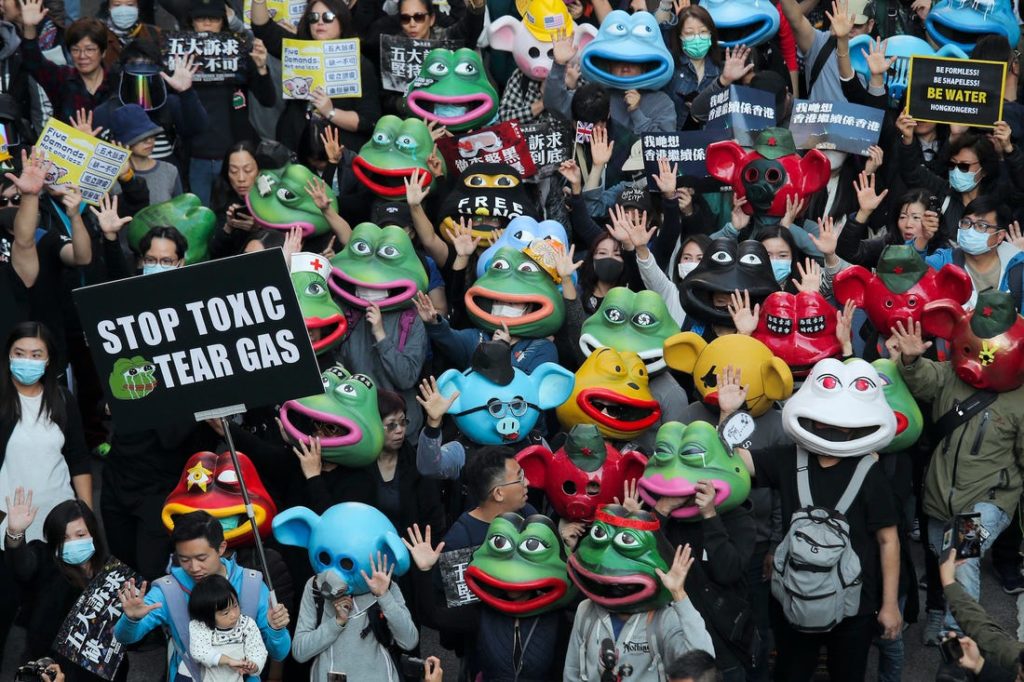A review of Feels Good Man, a documentary film directed by Arthur Jones.
It was while skulking on the internet around 2008 that I first saw the image of Pepe the frog with his “feels good man” speech bubble. I thought to myself, ha, cool, this looks fun – what’s the story behind this? I soon found the comic that the frog had been pulled from: a humorous take of Pepe urinating with his pants around his ankles and a carefree attitude about what his friends thought about it. I didn’t really think much about the cartoon frog until a few years later, when I learned that he had become a symbol for the alt-right. I wondered how something so innocuous could wind up becoming a symbol of hate. The documentary Feels Good Man answers that question.
The documentary begins by explaining how the creator Matt Furie came up with Pepe and his fellow roommates Andy, Brett and Landwolf for his deadpan comic Boys Club. With social media in its infancy, Matt began uploading his comics to MySpace and soon, his comics started to spread across the internet — in particular, his comic featuring Pepe saying the line “feels good man” in the last panel. Sometimes it was just the catchphrase “feels good man” or the image of Pepe with his speech bubble in a post on a forum, but eventually it made its way to the anonymous imageboard site 4chan, where it became a full blown meme, along with the various spinoffs that had morphed from the original image. Matt had a very relaxed attitude to the memefication of his work, seeing no harm in other artists having fun with his creation.
As Pepe became more ingrained in the culture of 4chan, its base of socially-disconnected users started to take a form of ownership over him, almost becoming a meme mascot. At the same time, celebrities and social media influencers had also taken notice of Pepe and had started to use Pepe memes in their posts, trying to take him mainstream. 4chan users, unhappy that “normies” had co-opted their Pepe, struck back, creating the most outrageous, obscene and offensive versions of the frog as a way to poison his use for those outside of 4chan. The hate and violence associated with Pepe soon ramped up to being associated with mass shootings — all the while using the ironic “it’s just a joke, nobody really means it” excuse to cover the harm and death associated with these images.
Fast forward to the 2016 presidential election period, and 4chan got behind Donald Trump, seeing him as a figure that aligned with their beliefs and who users could support. The Pepe Trump memes started appearing in what is now dubbed “the Great Meme War”, an attempt to sway the election with memes. The memes flooded out and eventuated with Trump tweeting out a Pepe Trump. 4chan saw this as a victory and realised that their memes could have an influence in the realm of politics. While all this is going on, the alt right were also using Pepe as a symbol and mascot to code their hateful rhetoric and views. Pepe seemed to be a perfect match for them, with the already-established “it’s just a joke” excuse bolstered by the argument that the people who spoke out against it were overreacting, getting worked up over a cartoon frog. All this resulted in the Anti-Defamation League listing Pepe as a hate symbol.
The rest of the documentary covers Matt Furie’s journey to try and take back control of his creation. The publishing of an islamophobic children’s book using Pepe as a main character, and the listing of his creation as a hate symbol, are the main drivers for the change from his hands-off attitude. While some of his more creative approaches have accomplished little, his legal approach has had many small wins by using copyright law to stop figures such as Alex Jones using and profiting from Pepe. However, his fight to remove Pepe from the hate symbol list will require much more time and effort to accomplish and may never happen, now that Pepe has been so ingrained in the right.
The film ends with one surprising story: the use of Pepe in the recent democracy protests in Hong Kong. Here, Pepe was not used as a symbol of hate but one of hope, freedom, and protest; a way to resist authoritarianism. That such a hateful symbol in the West can be reclaimed and changed to a symbol of hope elsewhere in the world shows that maybe one day Pepe could leave the ugliness of what he has become.
This documentary is a must-watch if you want an insight into meme culture or the workings of the dark side of the internet over the last decade. While it goes down some offbeat tangents in parts, it conveys the main point well. It shows how something as simple as a cartoon frog can be easily co-opted and corrupted to become a political device or a symbol of hate and bigotry. The documentary is presented in a bright and colourful fashion but due to the subject it is covering has some vile and disturbing content, so is definitely not for everybody.








